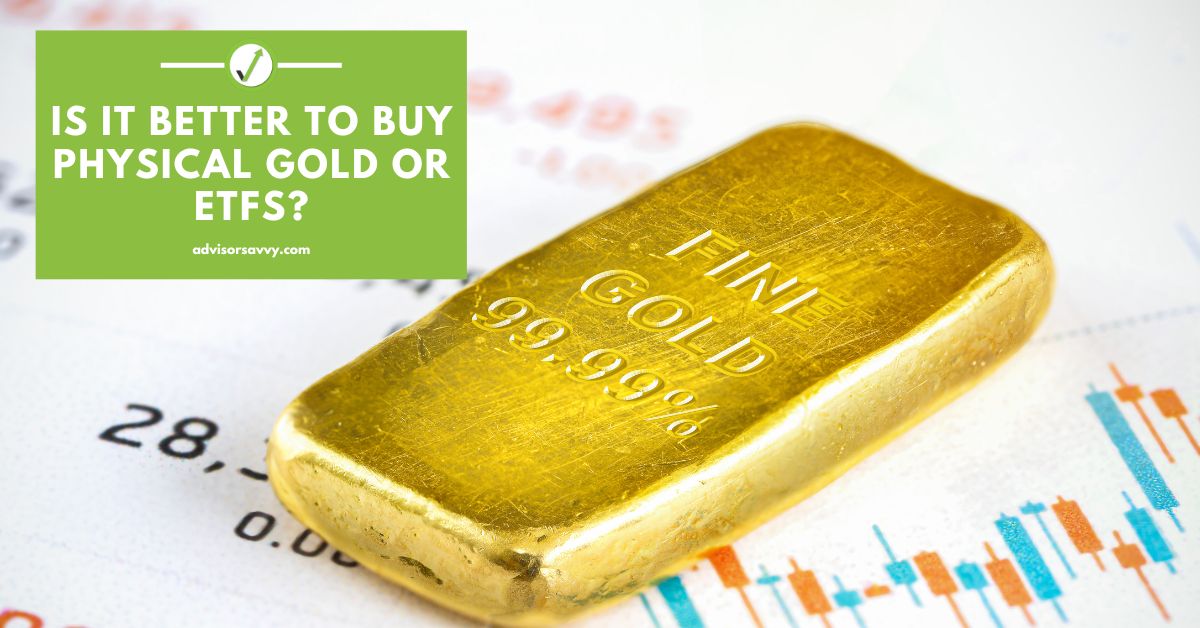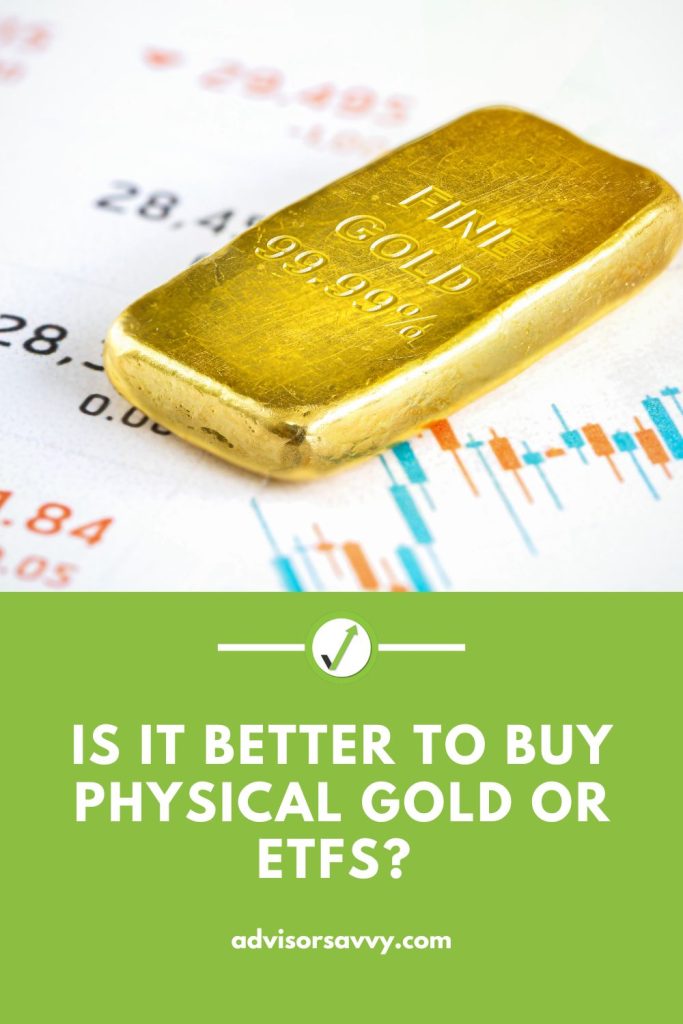
Inflation dwindles cash savings over time, so investing is paramount for financial freedom. But with so many investment options, it becomes difficult to pinpoint the right ones. Of course, you can’t put all your eggs in one basket. That’s where diversification comes in, to minimize risk and protect your investment portfolio. As you consider investments, you may have come across physical gold and gold ETFs. Two wildly different options, yet both with unique risks and benefits. So, is it better to buy physical gold or ETFs in the gold industry?

Table of contents
In this article, we’ll uncover the difference between ETFs and real gold as investments to help you decide which might be more ideal in your portfolio.
What is the difference between gold and gold ETFs?
Gold is one of the world’s most precious metals, found all over the world in hot rocks, quartz veins, and gravel deposits. It becomes heavy with weight, but it’s one of the most malleable metals, molded into endless shapes for jewelry and pressed thin into leaves. You might keep gold jewelry in your bedside drawer or lock it in a safety deposit box. The latter, or a local safe, are more reasonable storage locations for larger quantities of gold.
Before we get into gold ETFs, let’s narrow down what we mean by ETF. ETFs are exchange-traded funds with pooled investments from hundreds or thousands of individual investors. Anyone can purchase or sell them on the stock market at any time, and their value fluctuates depending on the market.
Gold ETFs are a type of ETF that partakes in the gold industry in some way. Imagine having a piece of a gold asset without actually having the physical commodity in your hand. In other words, ETFs tend to track a particular index while partaking in a particular market. With gold ETFs, they usually invest in the gold industry and track a related index.
Related Reading: Best Money Market ETFs in Canada

Match to your perfect advisor now.
Getting started is easy, fast and free.
Physical Gold vs Gold ETFs
Here’s a quick comparison table differentiating gold from gold ETFs:
| Physical Gold | Gold ETFs | |
| Storage | Requires a safe, secure space like a safety deposit box or local safe | No physical storage necessary |
| Risk | Relatively low risk and tangible as an investment; theft risk unless you keep it at a bank or somewhere physically secure | Relatively low: Harder to steal but subject to counterparty and market risk |
| Purity | Different purity grades; make sure you have the gold verified by a reputable source | Not applicable |
| Liquidity | Easily bought and sold, albeit requires physically visiting various people and businesses | Easily bought and sold every day, all online |
| Investment | Bigger upfront investment required; as high as 20% in fees | Investments can be small, more accessible; transparent, small percentage-based fees |
| Overall costs | Insurance, storage, verification, and fees make physical gold more expensive to maintain and acquire | Cheaper, requiring no insurance or storage, and lower fees |
| Market fluctuation | Physical gold is a secure investment and retains value and fights inflation | Fights inflation but ETFs are more vulnerable to a market collapse |
| Control | You have complete control over the investment and privacy | You’re vulnerable to the banks and owners who manage your investment |
Related Reading: Investment Management Fees: A Complete Guide
Which is better, gold ETFs or physical gold?
The answer depends on your current portfolio, risk tolerance, budget, and values. If you already have a solid 10% investment share of physical gold, you might be better off diversifying with ETFs — and vice versa.
If you have a smaller investment to work with? Gold ETFs are much more accessible and come with fewer fees and expenses. If you’re just starting out as an investor or are a micro-investor, it will be easier to get into gold ETFs as opposed to buying physical gold.
On the other hand, physical gold has a doomsday appeal that might bring comfort and security to investors. Citizens of countries that have experienced economic collapse maintained their financial health through gold and other precious metals. The reason is that gold and precious metals tend to retain their value, regardless of what’s happening in the market. Whereas other investments may be dependent on the success of the market.
Of course, this is more of a concern for countries with weaker currencies. Canada and the US have strong currencies, more so than some unstable countries in South America, for example. Still, you have more control over the investment because it’s in your hands, and nobody can change that. Even if it’s a bit tricky to store and transport.
One main drawback of a gold ETF is you can’t actually access the physical gold. You’d need a substantial stake in the ETF to do so. And in any case, you’re not really buying gold with an ETF, but rather a stake in the overall gold market. On top of that, the ETF can decide whether to pay you in gold or cash, and that’s if it’s even backed by physical gold.
Bottom line? Both would be best! But if you could only pick one, consider your values, budget and risk tolerance.
Related Reading: 5 Best Canadian Silver Stocks
Is physical gold a good investment in 2023?
Again, it depends on your financial goals. With inflation rising, gold is an attractive investment for its stability and long-term value retention. Some people are concerned and wary of an incoming recession or economic collapse. For this reason, buying physical gold can be a good strategy to weather any problems down the road. Plus, it’s a historically strong investment that’s experienced impeccable long-term growth over the long-run.
Still, it’s relative to your goals and current portfolio. If you have a tight budget, you might not be able to invest enough to keep your gold safe. In addition, markets always bounce back after a recession at some point or another — trust the process!
Where to buy physical gold in Canada
Here are a few spots to buy physical gold in Canada:
- Banks: The big banks are your easiest bet for gold bars. TD, Scotiabank, RBC, CIBC, and BMO all sell gold, though they usually impose a maximum $10,000 limit per purchase. Still, read up on each bank’s policies regarding buying back gold. Some banks only purchase gold sold from them in the first place, while Scotiabank stopped buying back any gold in 2022.
- Dealers: You might consider private dealers with strong reputations online to purchase gold, but they’ll likely charge you a higher commission than banks. Check the Canada Gold Directory for credible dealers.
- Pawn shops: “Cash 4 Gold,” anyone? You can certainly buy gold sheets or bars at established pawn shops; just ensure they appraise the bars before you buy. Additionally, you could purchase gold collectible coins at these shops.
- Jewelry shops: Don’t feel like lugging around a gold bar? Wear your investment or keep it somewhere safe. Gold jewelry is just as precious and retains its value.
Now, where do you keep it?
Where to store physical gold
At minimum? A local safe in your home. Definitely not under your mattress! But even safes aren’t foolproof, especially if you’re robbed. Keeping gold at home does have its appeal, though. It’s anonymous, and a great investment to lean on without banks or governments in your business. However, it comes with much more risk, and you’re put in a horrible position if you lose it. Plus, a thief could simply steal a safe, even a heavy one with some effort.
You might rent a safety deposit box at a bank or other provider, which is likely your best bet. Despite a monthly fee, you’ll protect your gold with the CDIC’s insurance. Some banks even offer to store your gold for you free of charge, but these are usually arrangements where they have the right to move it around. Safe deposit boxes offer more ownership in general.
Related Reading: Best Canadian Stocks: Top Picks for 2022
Top Gold ETFs in Canada
So, which gold ETFs can you choose from? We’ll get you started with our top three favorites, two backed by physical gold and the other by gold mining companies.
1. iShares (BlackRock)
CGL has a long, proven track record of returning the same investment performance of gold while saving you the fees. Still, its expense ratio of 0.55% is considered high across other options. This ETF manages a neat $922 billion, offering shares since 2009.
- Stock price at time of writing: $14.83
- Investment: Gold Bouillon
- Expense ratio: 0.55%
- Ticker: CGL/CGL-C
2. BMO Equal Weight Global Gold Index ETF
This ETF is an investment in gold mining companies rather than physical gold bullion. High risk, high reward — gold mining stocks are super sensitive to any price fluctuation in physical gold.
- Stock price at time of writing: $67.75
- Investment: Global Gold Miner Stock
- Expense ratio: 0.61%
- Ticker: ZGD.TO
3. Purpose Gold Bullion Fund
Purpose Investments offers this ETF backed by gold bullion as well as gold certificates, the latter of which might pose more risk. Still, the low expense ratio makes it an attractive option.
- Stock price: $27.40
- Investment: Gold Bullion
- Expense ratio: 0.25%
- Ticker: KILO.TO/KILO-B.TO
Of course, you have other options outside of these. No matter which you choose, look out for these qualities in Gold ETFs:
- Long track record: It’s easier to assess the performance of a Gold ETF established in 2009 than in 2019.
- Management expense ratio: Many lower-risk gold ETFs have MERs of under 0.5%.
- Gold bullion over gold mining companies: Depends on your risk tolerance – but gold bullion-backed ETFs will perform better in an economic downturn.
Related Reading: 7 Best Gold Stocks in Canada
What are the disadvantages of gold ETFs?
We mentioned the degraded ownership with ETFs earlier in this article. But perhaps the strongest drawback to ETFs is the lack of control, at least when compared to physical gold.
Gold ETFs make you susceptible to the risk of counterparty actions on your investment, forcing you to assume the custodian’s competence and integrity. Forbes reminds us of HSBC, one of the world’s top banks, and its subsequent scandals with money laundering and countless broken laws. While gold bullion ETFs are backed by physical gold, plenty of others aren’t, making them higher-risk investments. Yes, you might earn more money with a higher risk investment, but you could also lose everything.
Additionally, Gold ETFs fluctuate more in the stock market than physical gold does in value. Physical gold has also demonstrated a more profound growth historically.
Where to buy gold ETFs
You can buy and sell gold ETFs on any stock exchange where the investments are listed using your online trading account. The Toronto Stock Exchange is a good place to start. Or, you can have an investment or wealth manager purchase them on your behalf.
Related Reading: How to Buy Stocks
Should I buy physical gold or gold ETFs?
Gold ETFs offer more convenience and save you from liquidity, storage, and verification costs. However, physical gold offers more security in times of economic downturn, despite requiring a larger upfront investment. At the end of the day, the option you choose depends on your financial goals, risk tolerance and budget — good luck on your gold investing journey!
Read More: Best Canadian ETFs for 2022

